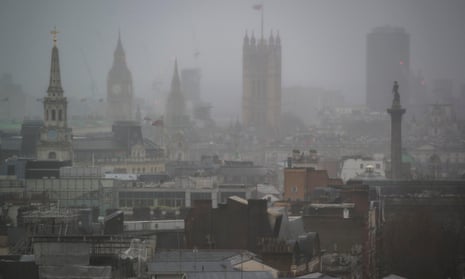EU states have agreed to water down a proposed law aimed at halving the number of deaths from air pollution within 15 years, after intense lobbying from the UK that cross-party MEPs have condemned as “appalling”.
Some 14,000 people will die prematurely every year across Europe from 2030 as a result, if the weakened proposal is implemented, according to figures cited by the environment commissioner, Karmenu Vella.
The revised proposal is likely to be rejected by the European parliament next week, setting the scene for a public row on 20 June, when Europe’s environment ministers meet to thrash out a compromise.
But EU diplomats said that the UK had been a key player in crafting a blocking minority to kill a more ambitious proposal to bring in measures that would result in a 52% improvement in pollution-related health impacts for citizens around Europe. This translates as a reduction in deaths from conditions such as stroke, heart disease and asthma.
One diplomat said: “They [the UK] gathered some of the environmental attaches in Brussels who they thought would be most willing to follow their line and weaken the directive. They talked to big countries, such as France and Italy, and I think they also discussed with the strongest ones in eastern Europe, like Poland.”
Seb Dance, the Labour parliamentary group’s environmental lead, said the UK was “a leading proponent of watering down the proposed target and [also] seems to be playing a leading role in the coalition of the unwilling”.
If agreed, the lower public health target proposed today – 48.5% – will be used as the basis for setting binding targets over the next 15 years for pollutants such as ammonia, sulphur dioxide (SO2), particulate matter (PM2.5) and nitrogen oxides (NOx).
The UK stance was in part motivated by a desire to protect the dairy sector, despite research indicating that ammonia-based fertilisers – rather than Saharan dust – were responsible for Britain’s worst pollution event in a decade.
A government spokesperson said: “Tackling air pollution is a priority for this government and we are working with EU partners to agree ambitious and fair emission limits for key air pollutants from 2030.”
Conservative MEP Julie Girling said: “The current proposal is simply not good enough and I think it is appalling. I would like to see the UK government leading the rest of Europe towards an ambitious programme. It is disappointing that does not seem to be the case.”
The difference between a 48.5% improvement in public health preferred by the UK and the 52% favoured by parliament “doesn’t sound a lot but that is actually a lot of dying people”, she said.
In a reference to the forthcoming referendum in the UK on EU membership, Girling added: “I understand that some people would say sovereign governments should be making these decisions. But they need to understand that if it were in the hands of our government, we would not be getting anything close to the ambition we think is necessary.”
The government’s own figures show that air pollution is responsible for between 40,000 and 50,000 premature deaths a year. An ongoing breach of the EU’s clean air directive will not be ended before 2025, according to the government’s own plans.
A letter to Liz Truss by the London and Paris mayors, Sadiq Khan and Anne Hidalgo, earlier this week, called for higher binding targets for 2025 as well as 2030, the closing of loopholes and curbs to methane emissions that cause ground level ozone.
Limits on methane, a potent greenhouse gas, had already been removed from an EU proposal seen by the Guardian, after pressure from the UK and other states, including France, Italy and Poland.
Farmers groups, though, argue that methane is currently covered under climate change legislation in the UK and that further emissions reductions need to take their financial situation into account
Diane Mitchell, the National Farmers Union’s environment adviser, said: “Agriculture does have a contribution to make and we are willing to play our part but it is important that if there are targets to be met, they are technically feasible and also affordable to the sector.”
Some 85% of ammonia emissions come from just 20% of the UK’s farms, mostly the largest ones, according to Eurostat data.
Calculations by the European Environmental Bureau (EEB) suggest that ammonia will be responsible for 4,000 of the 11,000 extra British deaths it expects between now and 2030 as a result of the UK’s weakening of the national emissions ceiling directive.
Louise Duprez, the EEB’s senior air quality officer, said: “Air pollution does not respect borders. European action is essential to stop citizens dying prematurely and contracting serious diseases.”









Comments (…)
Sign in or create your Guardian account to join the discussion